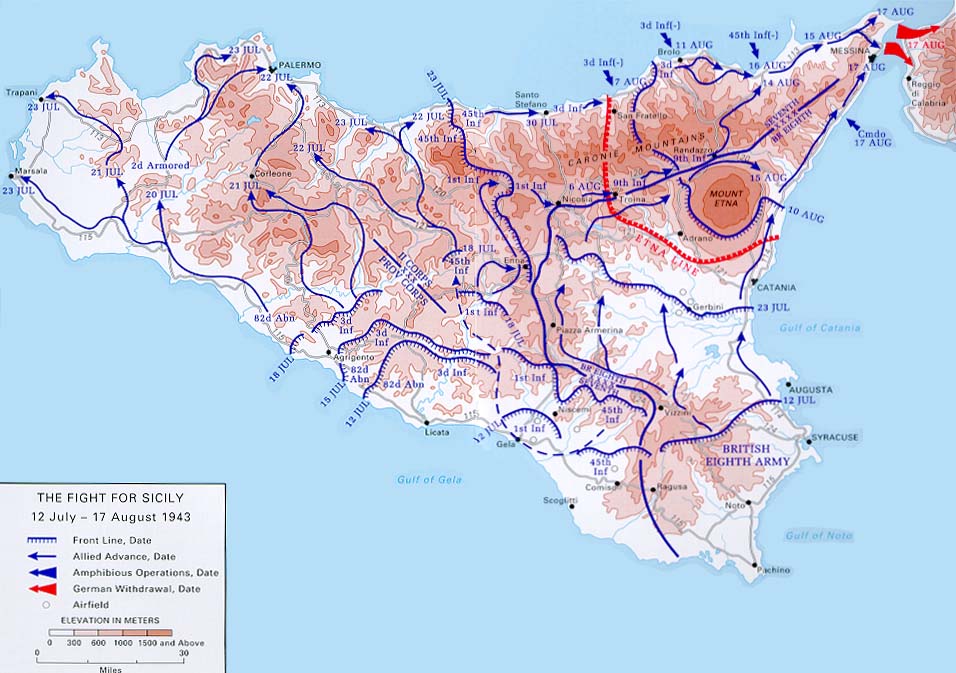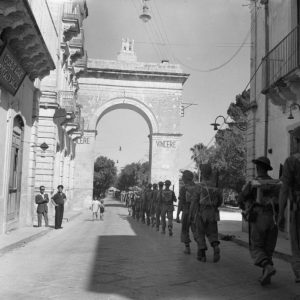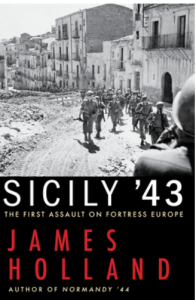Allied Invasion of Sicily
Allied Invasion of Sicily - Operation Husky
Overview
Map Source: Public Domain, https://commons.wikimedia.org/w/index.php?curid=99375
The Allied invasion of Sicily, codenamed Operation Husky, was a major campaign of World War II, in which the Allies took the island of Sicily from the Axis powers (Fascist Italy and Nazi Germany). It began with a large amphibious and airborne operation, followed by a six-week land campaign, and initiated the Italian Campaign.(1)
On the night of July 9-10 1943, an Allied armada of 2,590 vessels launched one of the largest combined operations of World War II— the invasion of Sicily. Over the next thirty-eight days, half a million Allied soldiers, sailors, and airmen grappled with their German and Italian counterparts for control of this rocky outwork of Hitler’s “Fortress Europe.” When the struggle was over, Sicily became the first piece of the Axis homeland to fall to Allied forces during World War II. More important, it served as both a base for the invasion of Italy and as a training ground for many of the officers and enlisted men who eleven months later landed on the beaches of Normandy. (4)
Strategic Setting
Overview
American military planners, led by Army Chief of Staff General George C. Marshall, argued that the Allies should focus their energies upon a direct thrust at Nazi Germany and not waste their time on smaller Axis outposts like Sicily. Marshall wanted to launch a cross-Channel attack into northern France as soon as possible, and all resources sent to Mediterranean reduced the forces available for an invasion of northern Europe.
In January 1943, at Casablanca, Morocco, Winston Churchill, rather than George Marshall, had his way. Roosevelt and Churchill wanted to do something further to divert Germany’s attention from the war against Russia. After studying a variety of options, the Casablanca conferees chose Sicily as the most appropriate sequel to the Tunisia Campaign. In return for undertaking the operation, the British reaffirmed the ultimate goal of a cross-Channel attack, and several months later the two powers fixed May 1944 for that event. Beyond this, there was no agreed upon plan.(12)
Picture Credit: By Parnall, C H (Lt), Royal Navy official photographer – http://media.iwm.org.uk/iwm/mediaLib//30/media-30134/large.jpgThis is photograph A 17916 from the collections of the Imperial War Museums., Public Domain, https://commons.wikimedia.org/w/index.php?curid=25272435

Operations
Troops and supplies unloading near Gela on D-day. (National Archives)
A Sherman tank moves past Sicily's rugged terrain. (National Archives)
Quick Facts:
| Date | July 9 – August 17 1943 |
| Location | French Morocco, French Algeria |
| Result | Allied victory |
| Strength | |
| U.S./ British/ Free France/ Canada/ Australia |
Initial strength:
|
| Germany/ Italy |
Ground forces: Italy: |
| Casualites / Losses | |
| Allies: | United Kingdom and Canada:
|
| Axis | Italy:
|
| Source: https://en.wikipedia.org/wiki/Allied_invasion_of_Sicily | |
Resources
Web Sites:
Books:
REFERENCES
- ** Top Image: The USS Yorktown is hit on the port side by a torpedo launched from a plane off the Japanese aircraft carrier Hiryu during the Battle of Midway on June 4, 1942. (Image: National Archives and Records Administration, 80-G-414423.)
- *M3 Tank Picture Credit: https://www.warhistoryonline.com/world-war-ii/ships-planes-tanks-operation-torch.html?chrome=1&A1c=1
- *George Patton Picture Credit: By Unknown author – https://ru.pinterest.com/pin/563864815825713713/, Public Domain, https://commons.wikimedia.org/w/index.php?curid=73447315
- (1) https://en.wikipedia.org/wiki/Allied_invasion_of_Sicily
- (4) https://history.army.mil/brochures/72-16/72-16.htm
- (12) https://history.army.mil/brochures/72-16/72-16.htm








